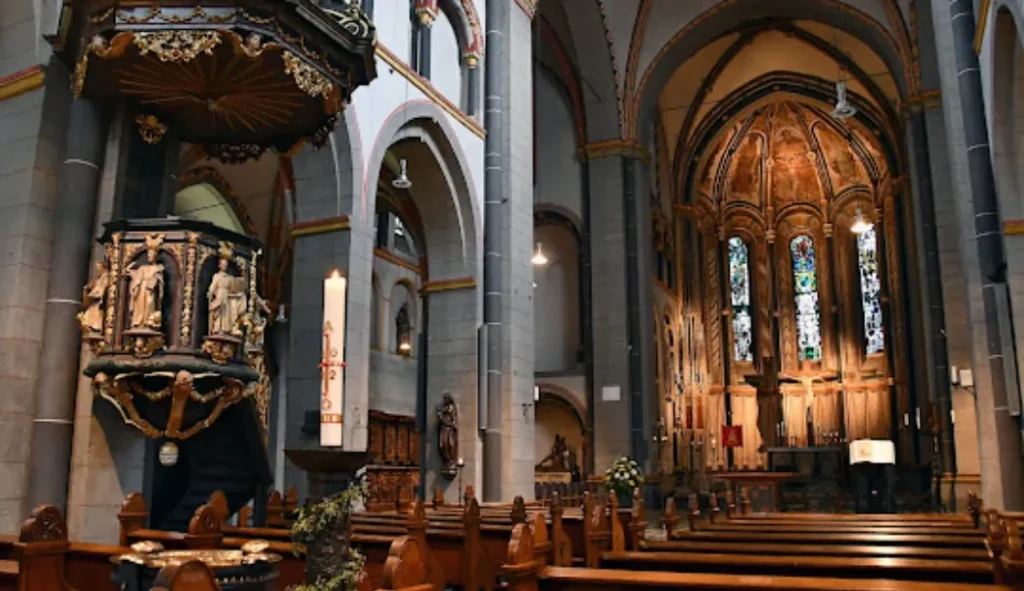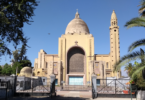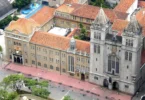Introduction

St. Margareta is a Catholic parish church in Düsseldorf-Gerresheim . Until 1803, the basilica was the collegiate church of the Gerresheim Women’s Foundation , which was founded in the 9th century and was one of the oldest canoness convents in the Archdiocese of Cologne. Since 1 January 2011, the parish of the same name also includes the former parishes of St. Cäcilia , St. Katharina , St. Maria vom Frieden , St. Reinold and St. Ursula in the east of Düsseldorf.
Away from the hustle and bustle of the fashion, trade fair and state capital Düsseldorf, in the middle of the eastern district of Gerresheim stands one of the most important church buildings in the Rhineland from the transition period from Romanesque to Gothic: the Staufer pillar basilica of St. Margareta.
Whether you come up from Düsseldorf city center from the south or west or drive down from the north or east, you can always see the tower of the basilica floating above Gerresheim. From a distance, the tower of the basilica provides orientation: on the way to the basilica – on the way through our lives.

The monastery, founded under the patronage of St. Hippolytus, was first mentioned in 870 on the occasion of the Cologne Synod and was first documented in 905/906. The founder is considered to be the Franconian nobleman Gerrich , who appointed his daughter Regenbierg (870–905) as the first abbess of the women’s convent . The place name Gerresheim is also associated with him in the document of 870. The women’s monastery is the second oldest ecclesiastical institution in the Rhineland after Kaiserswerth.
The convent was destroyed in 919 by an invasion of the Hungarians. The canonesses were able to flee to St. Ursula in Cologne and thus brought the valuable relics of St. Hippolytus to safety in Cologne. The reconstruction was not completed until 970 and the consecration was carried out by Archbishop Gero of Cologne , whose predecessor Wichfrid had provided great financial support for the monastery. After the turn of the millennium, the monastery began a period of prosperity again. This favorable development was due to a temporary affiliation with the neighboring monastery of Essen, whose abbess Theophanu (d. 1058), the famous granddaughter of Emperor Otto II, also led the Gerresheim monastery at the same time.
The present pillar basilica of St. Margaret was built between 1220 and 1230 as a collegiate church in the Rhenish transitional style and was probably consecrated in 1236. Like the monastery, the church was dedicated to Saint Hippolytus and was called Monasterium Santi Hippolyti . It is located on the site of a previous building from the 9th century. In keeping with the importance of the monastery, the basilica was built under Abbess Guda (1212–1232).
In the 13th and 14th centuries, the foundation was very wealthy and powerful due to numerous properties and income from the entire Rhineland. The high reputation among the nobility and the supra-regional influence are evident in the fact that only daughters of the high nobility were allowed to join the convent. The rich income from the landed property ensured the continued existence of the foundation until the beginning of the 19th century. The foundation was abolished in the course of secularization on September 12, 1803 by Elector Maximilian IV Joseph .
Since 1598, the blood procession has taken place every year to venerate a blood relic that is said to contain the earth from Mount Golgotha mixed with Christ’s blood. The basilica was originally reserved exclusively for the canonesses, and has only been used as a parish church since the 18th century. Until then, the community celebrated its services in a small church of Saint Margaret to the south, where the bones of the blessed Gerrich , the namesake of Gerresheim, were kept. From 1790, parish services were held in the collegiate church, which was finally transferred to the community in 1810; the old parish church had to be demolished in 1892.
Restorations were carried out in 1873 by Heinrich Wiethase and in 1894 by Heinrich Renard . Further restorations and structural safety measures were carried out from 1932 and 1950. Since 1975, safety measures have been carried out due to the unsafe building ground. During the restorations in the period from 1974 to 1985, the outer walls were plastered and painted in a colour that probably corresponds to the original colour. The church was elevated to a minor basilica by Pope John Paul II in 1982.

The exterior of the church is characterized by the uniformity of its architecture and its uniform shape. The basilica style is evident on the west façade with its raised central nave and low side aisles , as well as the two-storey, octagonal church tower with its pointed folding roof. The interior, on the other hand, is characterized by the entire wealth of shapes and colors of Rhenish late Romanesque . Early Gothic influences can already be seen in the wall structure, in the sense of a certain lightness in comparison to the Romanesque style. Of the monastery buildings from the 13th century, the cloister is still partially preserved. The external character (cruciform basilica meets central building), and above all the window shapes (half rose and cross), are rare and can only be found in the Rhineland in its “sister church” St. Peter in Sinzig . Neither church has a crypt.
Work of Art
High Gothic sculpture with architectural motifs is shown in the Gerricus Sarcophagus , a tomb carved from a single block of trachyte . It is decorated all around with pointed arches with finials and battlemented turrets. The work, which dates from around 1270/80, was probably created in a Cologne workshop.
The painting of the apse, which is of great artistic significance, dates from the time of its construction. In the vaulted center, the Trinity of God can be seen in the form of the mercy seat : God the Father sits enthroned and holds the crucified Christ in front of him, between the two is the dove as a symbol of the Holy Spirit, framed by the four evangelists. The Gerresheim mercy seat is considered to be the earliest in German monumental painting.
The larger-than-life crucifix above the altar comes from the previous building . The more than two-meter-high (2.10 × 1.80 m) Ottonian oak sculpture was probably made around 960 according to the latest findings and is related to the consecration of the church in 970. The corpus still shows traces of the original painting. The small shape of the body and the soft features of the face are striking in the depiction of Christ . It was probably donated by the Archbishop of Cologne. Along with the Gero Cross in Cologne, it is probably the oldest surviving high cross in Europe north of the Alps. Researchers consider the crucifix to be the oldest surviving monumental sculpture in Germany.
The neo-Gothic Hippolytus Shrine, made in 1871 by the Cologne artists Heinrich and Johann Bong, has housed the relics of St. Hippolytus since 1953, which had previously been stored in St. Ursula in Cologne since the Hungarian invasion of 919. The gilded shrine is decorated with portraits of the apostles and, on the gable sides, with figures of the Madonna and Child and St. Hippolytus.
he late Gothic Virgin Mary with the halo, created at the end of the 15th century , is supported by a 2.13 m high wrought iron chandelier that stands next to the crossing pillar at the entrance to the choir. The sculpture probably comes from the workshop of Kersten Woyers (ca. 1470–1531) in Venlo. Of the high altar , which was built before 1236, only the three-part substructure, decorated with columns and trefoil panels, which was made of trachyte, still exists – the material of the altar plate is bluestone.
Church Treasury
The basilica’s treasury has been housed in the former baptismal chapel since 2013. As early as the early Middle Ages, people began collecting valuable sacred objects such as reliquaries, chalices, monstrances and chasubles. During the secularization that began in 1806, many of the church’s art treasures were lost.
Feast Day
Feast Day : 20 July
Margaret, known as Margaret of Antioch in the West, and as Saint Marina the Great Martyr (Ancient Greek: Ἁγία Μαρίνα) in the East, is celebrated as a saint on 20 July in Western Christianity, on 30th of July (Julian calendar) by the Eastern Orthodox Church, and on Epip 23 and Hathor 23 in the Coptic Orthodox Church. She was reputed to have promised very powerful indulgences to those who wrote or read her life or invoked her intercessions; these no doubt helped the spread of her following. Margaret is one of the Fourteen Holy Helpers and is one of the saints with whom Joan of Arc claimed to have spoken.
Church Mass Timing
Monday : 09.00 AM
Tuesday : 09.00 AM
Wednesday : 09.00 AM
Thursday : 09.00 AM
Friday : 09.00 AM
Saturday : 07.15 AM and 06.15 PM
Sunday : 09.30 AM and 11.15 AM
Church Opening Time:
Monday : 10.00 AM to 06.00 PM
Tuesday : 10.00 AM to 06.00 PM
Wednesday : 10.00 AM to 06.00 PM
Thursday : 10.00 AM to 06.00 PM
Friday : 10.00 AM to 06.00 PM
Saturday : 10.00 AM to 06.00 PM
Sunday : 02.00 PM to 06.00 PM
Contact Info
Address :
Gerricuspl. 6, 40625 Düsseldorf, Germany
Phone : +49 211 289330
Accommodations
Connectivities
Airway
Basilica of St. Margaret, Düsseldorf, Germany to Dusseldorf (DUS) Distance 20 min (17.7 km) via A44.
Railway
Düsseldorf Central Station to Basilica of St. Margaret, Düsseldorf, Germany 22 min (6.6 km) via Dreherstraße.








